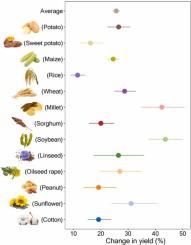当前位置:
X-MOL 学术
›
Field Crops Res.
›
论文详情
Our official English website, www.x-mol.net, welcomes your
feedback! (Note: you will need to create a separate account there.)
Effects of plastic film mulching on yield, water use efficiency, and nitrogen use efficiency of different crops in China: A meta-analysis
Field Crops Research ( IF 5.6 ) Pub Date : 2024-05-13 , DOI: 10.1016/j.fcr.2024.109407 Tiantian Huang , Qianxiang Wu , Yangyang Yuan , Xintong Zhang , Ruiqi Sun , Rui Hao , Xiaohua Yang , Congfeng Li , Xiaoliang Qin , Fangqi Song , Charles O. Joseph , Wen Wang , Kadambot H.M. Siddique
Field Crops Research ( IF 5.6 ) Pub Date : 2024-05-13 , DOI: 10.1016/j.fcr.2024.109407 Tiantian Huang , Qianxiang Wu , Yangyang Yuan , Xintong Zhang , Ruiqi Sun , Rui Hao , Xiaohua Yang , Congfeng Li , Xiaoliang Qin , Fangqi Song , Charles O. Joseph , Wen Wang , Kadambot H.M. Siddique

|
Rainfed agriculture is crucial for global food security, with plastic film mulching a widely adopted practice in this domain. However, the impact of plastic film mulching varies significantly across different crop species. This study conducted a comprehensive meta-analysis to evaluate the overall effects of plastic film mulching on the yield, water use efficiency (WUE), and nitrogen partial factor productivity (NPFP) of 13 different crop species. Plastic film mulching significantly enhanced crop yield (26%), WUE (33%), and NPFP (26%) compared to non-mulched conditions. However, the promotional effects varied significantly among different crop species, with noteworthy improvements observed in soybean (44%, 41%, and 45%, respectively) and millet (42%, 57%, and 39%, respectively). For China’s major staple crops, plastic film mulching improved the yield, WUE, and NPFP of wheat (29%, 23%, and 27%, respectively), rice (12%, 36%, and 12%, respectively), maize (25%, 29%, and 26%, respectively), and potato (27%, 29%, and 27%, respectively). Regional suitability for plastic film mulching varied among different crops, with rice, maize, soybean, sunflower, linseed, and millet showing increased benefits in cold, semi-arid and arid areas (mean annual temperature (MAT) ≤ 10°C, mean annual precipitation (MAP) < 450 mm, and aridity index (AI) < 0.5). Conversely, peanut and wheat performed better in warm, moist and semi-humid regions (MAT > 10°C, MAP > 450 mm, and AI > 0.5). Moreover, nitrogen fertilizer application influenced the efficacy of plastic film mulching. For soybean, linseed, and millet, the optimal outcome of plastic mulching was observed under low nitrogen application (<110 kg ha). For sorghum, sunflower, sweet potato, rice, peanut, potato, and wheat, the optimal outcome of plastic mulching was found under moderate nitrogen application (110–220 kg ha). As for maize, cotton, and oilseed rape, the optimal outcome of plastic mulching was observed under high nitrogen application (>220 kg ha), but there was no significant difference between moderate and high nitrogen application. A tailored approach considering specific crop requirements and nitrogen application rates is essential for maximizing the benefits of plastic film mulching across diverse local conditions. This study offers valuable insights into optimizing crop productivity under plastic film mulching management systems.
更新日期:2024-05-13
















































 京公网安备 11010802027423号
京公网安备 11010802027423号